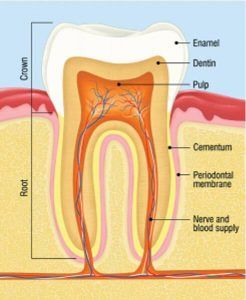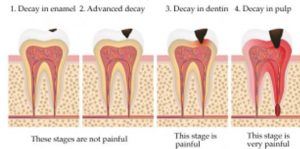Dental cavities can turn that smile upside down
By Dr. Salina Suy

Figure 1
Welcome to the first segment in my next series “Defining Dentistry,” where I will be explaining dental terminologies and procedures.
Let us begin with the famous dental cavity.
So what really is a cavity?
It’s the dreaded word from our dental check-ups and something we are hoping our dentist does not find. Dental cavities are the result of a series of events. They are areas of enamel — the outermost layer of tooth — that have softened and decayed.
First, let’s talk about how dental cavities form.
There are several layers in teeth; let us go over basic anatomy.
Pictured in figure 1 is a tooth cut in half and we can observe the layers.
- Enamel: the outermost and strongest layer of the tooth crown
- Dentin: the underlying layer that houses communication tunnels to the pulp
- Pulp: The area that holds the tooth nerve, blood and nutrients. It has a pulp chamber at the top and pulp canals at the bottom.
- Cementum: The layer that forms around the roots of the tooth.
Now imagine this: Everyone’s mouth has natural bacteria that provide a natural defense and are the first players in our digestive tract.
When we eat, a layer of food can remain on our enamel, especially if we do not remove debris with proper hygiene techniques, such as tooth brushing and flossing.
Breaking down enamel
If this layer of food remains on the enamel surface, our natural bacteria will digest the food we leave behind. When bacteria digest the food, they secrete acid — a byproduct of their digestion.
This acid from the bacteria breaks down our enamel, making it soft and vulnerable.
Once the enamel layer is broken, dentin will easily decay at a rapid rate. Cavities can be small and possibly regenerate. Cavities can also be big and indicate the need for a filling, crown, root canal or even an extraction in some cases.

Figure 2
Figure 2 is a great picture showing the stages of tooth decay and how a small problem can lead us to bigger problems.
- Stage 1: A healthy tooth that has some plaque on it but no cavities. Plaque is a film that is made from the things left on our teeth such as food and drink. If we brush our teeth, floss and remove that plaque, it is no longer an issue.
- Stage 2: The cavity is starting to form in the outer layer. Sometimes, these cavities are small enough and can re-mineralize with some help. The use of products such as MI Paste® and fluoride can help bring the strength back to enamel.
MI Paste® is the only product for professional use containing Recaldent™, a special milk-derived protein that releases calcium and phosphate to the surface of the teeth.
- Stage 3: The cavity has now reached the dentin layer and the cavity can no longer re-mineralize in this layer. At this point, if the cavity is small enough, your dentist will suggest you get a filling.
What does that mean? Your dentist will take out all the soft areas and put in a material to fill the tooth back to normal. When fillings are large, your dentist may suggest a crown to protect the tooth.
- Stage 4: The cavity has now reached the pulp layer and the cavity has the potential to affect the nerve within the pulp.
At this point, the cavity may or may not be treated with only a filling. The nerve of the tooth can now become infected because it is exposed to decay.
At this point, your dentist might recommend a root canal to save the tooth if you have an infection or the nerve dies.
If the tooth cannot be saved, your dentist may recommend an extraction of the tooth to get rid of the source of infection.
I hope this helps you understand what a cavity really is.


 2607 Genesee St., Utica, NY 13501
2607 Genesee St., Utica, NY 13501  315-724-3197
315-724-3197